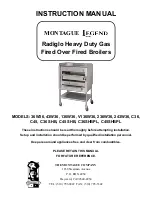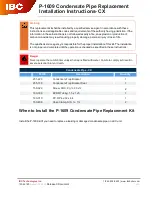
All joints other than push-on or plastic compression connectors must be made
and sealed with solvent cement suitable for muPVC pipes and conforming to BS
6209: 1982.
External wall faces and any internal faces of cavity walls must be made good.
2.9
AIR SUPPLY
The Keston is a room sealed appliance and therefore does not require purpose provided
ventilation for combustion air.
2.10
COMPARTMENT INSTALLATION
The casing temperature of the Keston 170 is very low. Due to this fact, no compartment
ventillation is required for cooling purposes.
2.11
CONDENSATE DRAINAGE
Being a condensing boiler, the Keston is fitted with a condensate trap at the base of the
heat exchanger and flue assembly, with facility to connect to a drain point underneath the
appliance.
Use only plastic piping
and do not reduce below 15mm internal diameter within the
dwelling. Condensate should preferably be drained into the sanitary waste system or,
alternatively, the rainwater system of the property.
Termination of the pipe must be either at a branch or stack internal to the house, or
externally at an open gully. Alternatively, discharge into a purpose made condensate
soakaway can be considered. Existing or purpose built drains must use suitable corrosion
resistant material as condensate is mildly acidic.
A minimum slope downwards towards the drain of 1 in 20 is essential. Freezing of the
termination and pipework must be prevented. Any drainage pipes outside the property
must be at least 32 mm
inside
diameter.
2.12
RADIANT FLOOR HEATING
The low operating temperatures of this type of system lead to very good operating
efficiencies. In fact, under floor heating can produce in excess of 95% operating efficiency
from a Keston condensing boiler.
Water temperatures in radiant floor heating systems must be kept relatively low, generally
under 48
o
C, so that surfaces do not become uncomfortably warm to the touch. If radiant
heating is only one application for a multi-zone system which also requires higher delivery
water temperatures for other zones (i.e. water heating, skirting heaters etc.) then the
radiant floor zone temperature will need to be controlled separately from the boiler.
If radiant floor heating is the only application of the boiler, the boilers maximum operating
temperature can be lowered accordingly by introducing a supplementary control
thermostat within the control system of the installation.
Mixing valves are also available which will mix return water from the system with boiler
output water to dilute the temperature of water transmitted to the distribution system.
Mixing valves may create problems with low flow and high temperatures through the
boiler, unless care is taken to design a system which will provide proper flows and will fully
load the boiler. Keeping the boiler's temperature high will prevent the boiler from operating
at peak efficiencies. Systems which maintain boiler temperatures in this way should be
avoided.
WD51/2/1997 Chapter 2 - Boiler Connections The Keston 170 Condensing Boiler
Installation & Servicing Instructions
Page : 14
















































